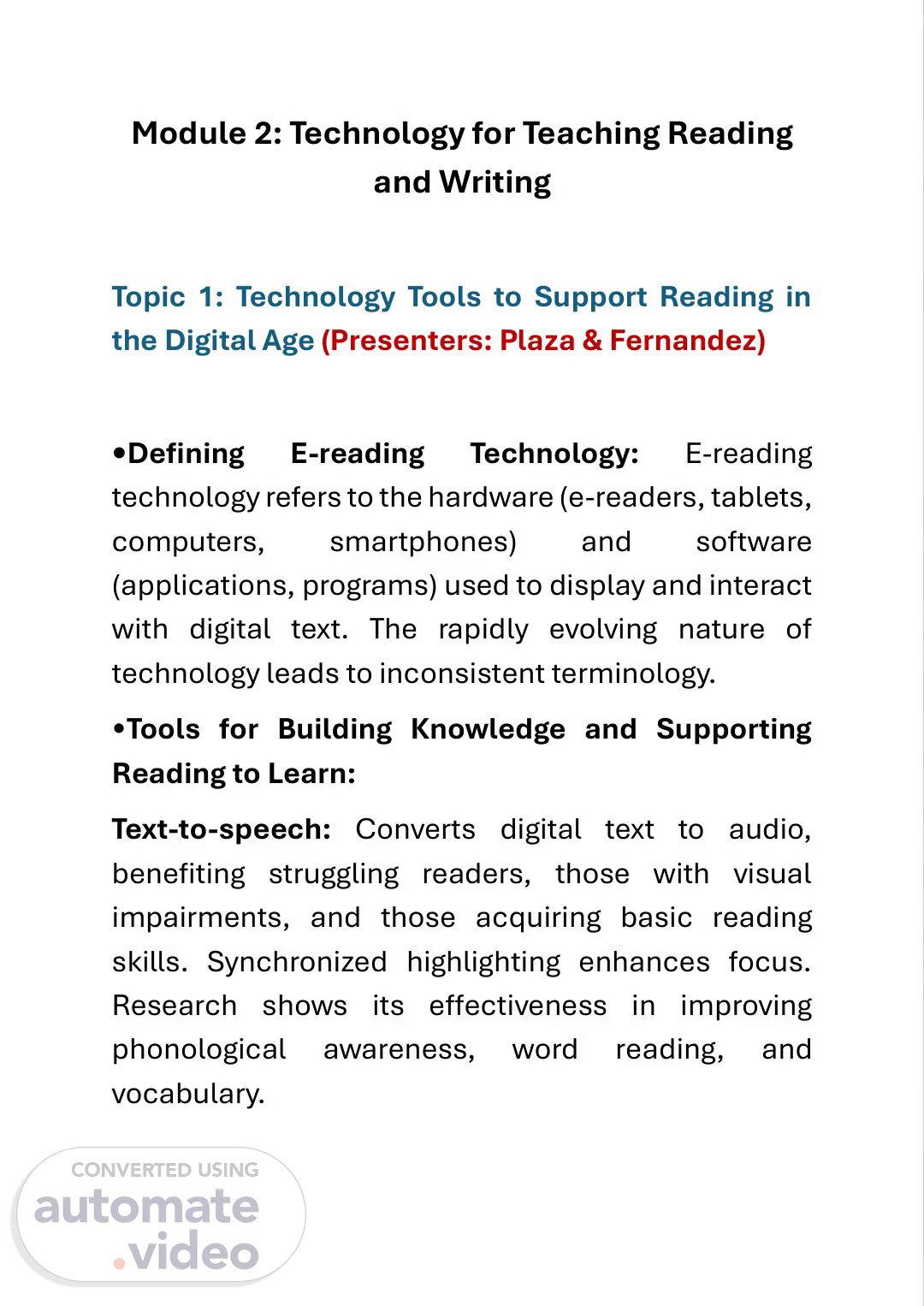
MOD.-2-Technology-for-Teaching-Reading-and-Writing-HANDOUTS (1)
Scene 1 (0s)
Module 2: Technology for Teaching Reading and Writing Topic 1: Technology Tools to Support Reading in the Digital Age (Presenters: Plaza & Fernandez) •Defining E-reading Technology: E-reading technology refers to the hardware (e-readers, tablets, computers, smartphones) and software (applications, programs) used to display and interact with digital text. The rapidly evolving nature of technology leads to inconsistent terminology. •Tools for Building Knowledge and Supporting Reading to Learn: Text-to-speech: Converts digital text to audio, benefiting struggling readers, those with visual impairments, and those acquiring basic reading skills. Synchronized highlighting enhances focus. Research shows its effectiveness in improving phonological awareness, word reading, and vocabulary..
Scene 2 (30s)
Multimedia supports: Integrating images, videos, and interactive elements improves engagement and comprehension. Studies indicate positive effects on word recognition and vocabulary, especially for at- risk children. Individualized practice opportunities: E-reading technology offers tailored practice and feedback, addressing individual student needs. Research shows benefits for struggling readers in various reading skills (fluency, vocabulary, comprehension). Computer-guided reading tutors: Build reading fluency and comprehension using speech recognition and feedback. Studies show improvements in fluency and spelling skills, particularly for second-language learners. Self-paced tutorials: Promote advanced reading skills (self-questioning, inference, summarization). Research demonstrates gains in these skill areas. Instructional agents: Animated avatars or voices provide immediate, individualized feedback, mimicking a teacher’s support on a larger scale. Studies show benefits in vocabulary, inference,.
Scene 3 (1m 5s)
metacognitive awareness, and strategy development. Digital graphic organizers: Provide structure for interacting with text, improving comprehension. Research indicates improved comprehension through structured interaction with text. Online multimedia resources: Augment classroom instruction and build background knowledge. Examples include resources from PBS and National Geographic. Online learning communities: Support individualized learning and collaboration beyond the classroom. Topic 2: Technology and Writing (Presenter: Limutin) •Computer-Assisted Classroom Discussion (CACD): Synchronous computer-mediated interaction among students, with or without the instructor. Research shows increased student.
Scene 4 (1m 30s)
participation, more balanced contributions, and a shift in control from teacher to students. Topic 3: Technology-Supported Writing Instruction (Presenter: Israel) •Supporting Struggling Writers Using Technology: Technology aids all writing phases (planning, transcribing, revising), enabling skills and teaching them simultaneously. New forms of writing and multimedia creation are also enabled. •Writing in the Adult Education Classroom: Technology provides scaffolds and supports for diverse writing needs. Instructors need skills to analyze and address learners’ various writing components effectively..
Scene 5 (1m 54s)
Topic 4: Strategies for Technology Use (Presenter: Vallente) •Planning and Organization: Technology tools (outliners, mind-mapping software) help organize thoughts and structure writing. •Transcribing: Speech-to-text software converts spoken words into written text. •Editing and Revising: Grammar and spell checkers, along with feedback tools, improve writing accuracy and clarity. Topic 5: Technology for All: Supporting Students with LDs (Presenters: Culiao & Baldelovar) •Planning: Technology aids in brainstorming and outlining..
Scene 6 (2m 17s)
•Composing: Speech-to-text and word prediction tools facilitate writing. •Speech-to-Text: Converts spoken words to text. •Word Prediction: Suggests words as the student types. •Revising: Technology provides feedback on grammar, spelling, and style. •Sharing: Easy sharing of work with teachers and peers facilitates collaboration and feedback..